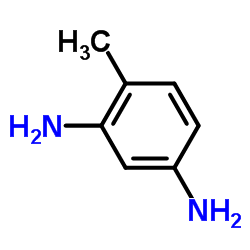2,4-Diaminotoluene

2,4-Diaminotoluene structure
|
Common Name | 2,4-Diaminotoluene | ||
|---|---|---|---|---|
| CAS Number | 95-80-7 | Molecular Weight | 122.168 | |
| Density | 1.1±0.1 g/cm3 | Boiling Point | 292.0±0.0 °C at 760 mmHg | |
| Molecular Formula | C7H10N2 | Melting Point | 97-99 °C(lit.) | |
| MSDS | Chinese USA | Flash Point | 149.5±21.3 °C | |
| Symbol |



GHS06, GHS08, GHS09 |
Signal Word | Danger | |
|
Development of QSAR models for predicting hepatocarcinogenic toxicity of chemicals.
Eur. J. Med. Chem. 44 , 3658-64, (2009) A dataset comprising 55 chemicals with hepatocarcinogenic potency indices was collected from the Carcinogenic Potency Database with the aim of developing QSAR models enabling prediction of the above unwanted property for New Chemical Entities. The dataset was... |
|
|
Consumer product in vitro digestion model: Bioaccessibility of contaminants and its application in risk assessment.
Regul Toxicol Pharmacol 44(2) , 161-71, (2006) This paper describes the applicability of in vitro digestion models as a tool for consumer products in (ad hoc) risk assessment. In current risk assessment, oral bioavailability from a specific product is considered to be equal to bioavailability found in tox... |
|
|
JaCVAM-organized international validation study of the in vivo rodent alkaline comet assay for the detection of genotoxic carcinogens: I. Summary of pre-validation study results.
Mutat. Res. Genet. Toxicol. Environ. Mutagen. 786-788 , 3-13, (2015) The in vivo rodent alkaline comet assay (comet assay) is used internationally to investigate the in vivo genotoxic potential of test chemicals. This assay, however, has not previously been formally validated. The Japanese Center for the Validation of Alternat... |
|
|
Biological monitoring as a valid tool to assess occupational exposure to mixtures of 2,4-:2,6-toluene diisocyanate.
Med. Lav. 103(5) , 361-71, (2012) Despite its advantages over environmental monitoring, biological monitoring of exposure to 2,4-:2,6-toluene diisocyanate (TDI) mixtures is still underused. The present study was designed in order to evaluate the feasibility and reliability of biological monit... |
|
|
Biochar-mediated reductive transformation of nitro herbicides and explosives.
Environ. Toxicol. Chem. 32(3) , 501-8, (2013) Biochar, a subset of black carbon produced via pyrolysis of biomass, has received much attention in recent years due to its potential to address many important issues, from energy and climate to agriculture and environmental quality. Biochar is known to influ... |
|
|
Improvement in the GC-MS method for determining urinary toluene-diamine and its application to the biological monitoring of workers exposed to toluene-diisocyanate.
Int. Arch. Occup. Environ. Health 78(6) , 459-66, (2005) To develop a simple and sensitive GC-MS method for determining toluene-diamine (TDA) in urine and to apply the method for biological monitoring of workers exposed to toluene-diisocyanate (TDI).After acid hydrolysis of 0.1 ml of urine, diluted tenfold with wat... |
|
|
LC-MS determination of urinary toluenediamine in workers exposed to toluenediisocyanate.
Toxicol. Lett. 134(1-3) , 259-64, (2002) To improve the biological monitoring method for 2,6- and 2,4-toluenediisocyanate (TDI) exposure, we developed a simple and rapid method for analysis of the corresponding urinary metabolites, 2,6- and 2,4-toluenediamine (TDA) using liquid chromatograph-mass sp... |
|
|
Syrian hamster embryo (SHE) cell transformation assay with conditioned media (without X-ray irradiated feeder layer) using 2,4-diaminotoluene, 2,6-diaminotoluene and chloral hydrate.
Mutat. Res. 654(2) , 108-13, (2008) The Syrian hamster embryo (SHE) cell transformation assay has traditionally been conducted with a feeder layer of X-ray irradiated cells to provide growth support to the target cells seeded in low numbers. The feeder layer of cells consists of X-ray irradiate... |
|
|
2,4-Toluene diisocyanate suppressed the calcium signaling of ligand gated ion channel receptors.
Toxicology 219(1-3) , 167-74, (2006) Toluene diisocyanate (TDI) is widely used as a chemical intermediate in the production of polyurethane. TDI-induced asthma is related to its disturbance of acetylcholine activity in most affected workers, but the relevant mechanisms are unclear. Toluene diami... |
|
|
Development of a repeated-dose liver micronucleus assay using adult rats: An investigation of diethylnitrosamine and 2,4-diaminotoluene
Mutat. Res. 747(2) , 234-9, (2012) Highlights ► We developed a repeated-dose liver micronucleus (MN) assay using normal adult rats. ► Chemical hepatocarcinogens significantly induced micronucleated hepatocytes in the assay. ► A new hepatocyte isolation technique without in situ perfusion was s... |